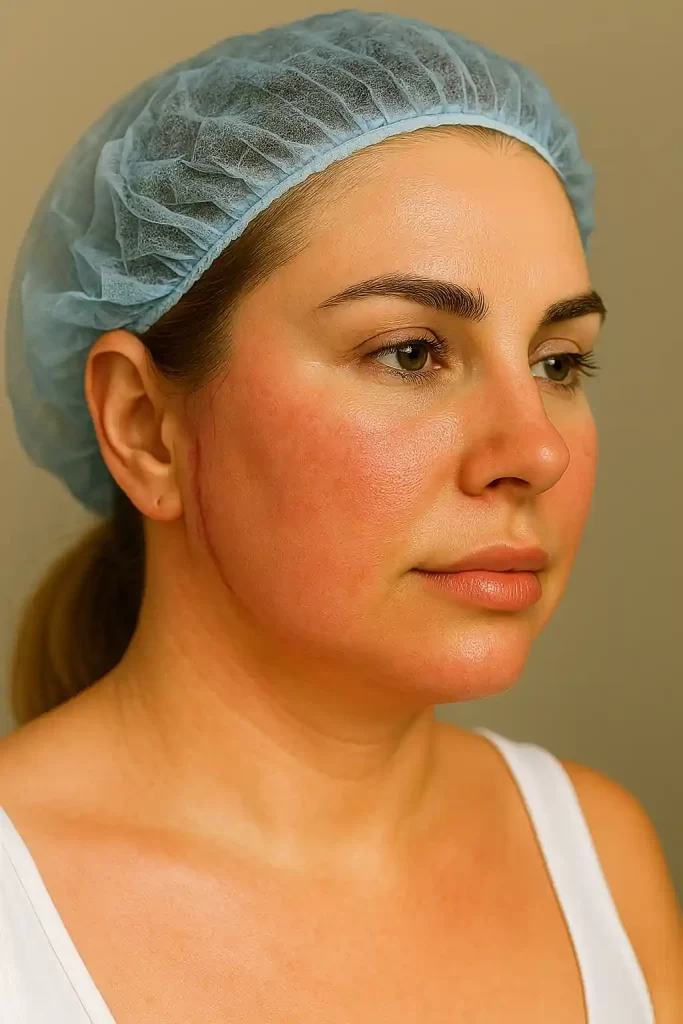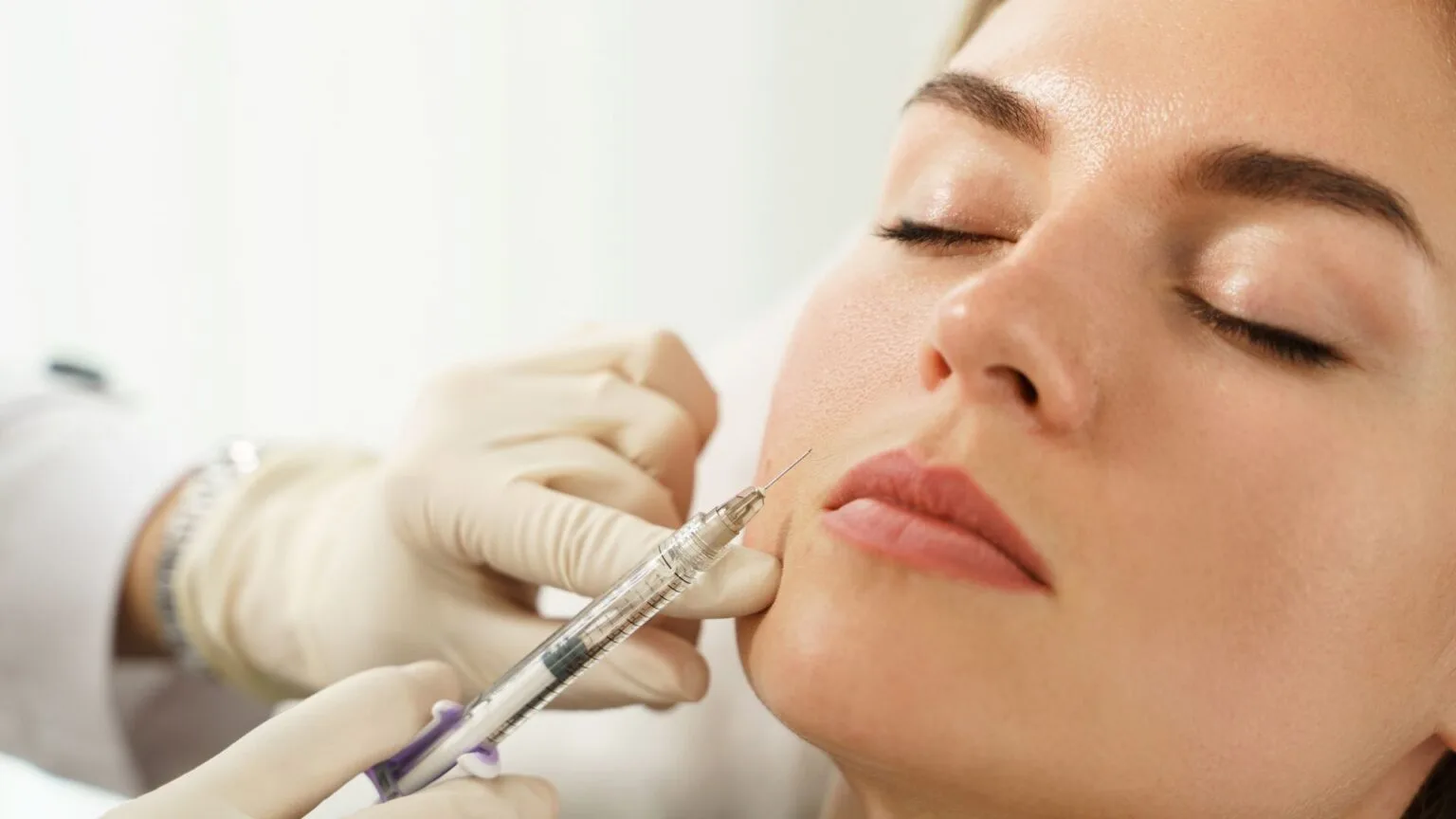It’s common to see still signs of swelling 4 weeks after facelift surgery. For patients at Kopelman Aesthetic Surgery, knowing what’s normal can ease concerns.
Dr. Kopelman helps patients understand the post-facelift recovery process and what persistent swelling may indicate.
If you’re also wondering what level of discomfort is typical, learn more about whether face surgery hurts and what to expect during recovery.
Table of Contents
ToggleFacelift Recovery Timeline
Week 3 to Week 6: What to Expect and What’s Normal
By week 3, most patients notice a reduction in bruising, but they still experience some puffiness. Mild tightness and residual swelling may remain. These signs typically fade with time and gentle care.

At 4 weeks after a facelift, swollen areas may be due to the body’s natural healing. Minor firmness or lumps under the skin can occur.
By week 6, most swelling typically resolves; however, full results may take several months to appear.
If you are still experiencing facial tightness or puffiness 3 weeks after facelift surgery, this is typically part of the standard recovery timeline.
Maintaining healthy habits during this phase helps the body continue healing efficiently.
Patients should feel comfortable returning to many daily activities during this phase. However, it’s important to avoid strenuous activities to prevent setbacks in the recovery period.
Takeaway: Minor swelling at week 4 is common and usually not a concern if no other symptoms appear.
Lower Facelift Recovery Time vs. Full Facelift
Lower facelift recovery time is generally shorter due to a smaller treatment area. Most patients return to light activity within 10 to 14 days.
Bruising and swelling typically resolve faster than with complete facelift procedures.
That said, recovery still depends on factors like skin condition, age, and adherence to the surgeon’s instructions. Whether undergoing a lower or complete facelift, protecting your skin and supporting healing is key.
For younger patients, it’s helpful to explore the best age to consider a facelift and how that influences recovery outcomes.
Takeaway: Recovery time may be shorter with lower facelifts, but consistent care remains essential.
Swelling 2–4 Months After Facelift

Swelling beyond 2 months is uncommon but not always concerning. Areas such as the jawline or under the chin may retain residual swelling for longer.
Using ice packs in the first weeks and maintaining a balanced diet can help reduce long-term inflammation.
Drinking plenty of water and getting enough rest support internal recovery. It’s also important to stay hydrated to support the body’s natural healing functions.
Takeaway: Isolated swelling may persist into month 3, especially in more vascular areas.
Tightness 6 Months After Facelift

Mild tightness at 6 months is not unusual. It may result from internal healing at the incision sites. In most cases, this sensation fades without intervention.
If tightness causes discomfort or interferes with facial movement, it’s essential to speak with your surgeon.
Dr. Kopelman often reassures patients that these late-stage sensations are a regular part of the healing process.
As swelling subsides and results appear, patients sometimes ask how to tell if someone has had a facelift, especially when outcomes are subtle and natural-looking.
Takeaway: Tightness at six months can be a regular part of the healing process, especially around scar tissue.
Facelift Swelling: Timeline and Concerns
How Long Does Swelling Last After a Facelift?
Swelling after a facelift typically peaks around the third or fourth day after surgery and gradually decreases. The first week after surgery is the most intense, with steady improvement over the next few weeks.
Most swelling resolves by week 4–6. Any remaining swelling is usually minor and improves over time. Staying consistent with follow-up care helps detect complications early.
Takeaway: Expect significant improvement by week 6, with only minimal puffiness beyond that point.
How Long Does Swelling Last After a Mini Facelift?
Mini facelifts involve less tissue disruption, so swelling often lasts 2 to 3 weeks. Some puffiness can persist longer depending on your body’s response and how well you follow recovery guidelines.
Keeping your head elevated during sleep and avoiding salt can help minimize swelling. Patients often return to work within 10 days of a mini facelift.
Takeaway: Mini facelifts typically involve a shorter swelling phase compared to complete procedures.
Why Am I Still Swollen 5 Weeks Later?
At 5 weeks, if swelling remains, it may be due to residual fluid retention or internal healing.
This is especially true in patients who had more extensive procedures or combined cosmetic procedures.
Persistent swelling doesn’t always mean something is wrong. Dr. Kopelman closely monitors each patient’s healing to ensure there are no signs of infection, seromas, or other complications.
You’re not alone if you’re still experiencing puffiness—this is a standard part of the healing journey. Reassurance and close follow-up can offer peace of mind.
Takeaway: Swelling at week 5 can still be normal, especially with combined treatments.
Hard Swelling After Facelift: Causes and Fixes
Hard swelling after facelift surgery can be caused by internal scar tissue or lymphatic buildup. These firm areas may feel like small bumps under the skin.
Gentle massage (if approved), hydration, and avoiding trauma to the area can help alleviate the discomfort.
In rare cases, surgical revision may be needed. Always consult your surgeon before attempting any treatment.
Red flags to watch for: increasing firmness, redness, or pain. These should be reported promptly.
Takeaway: Mild hardness is often temporary, but persistent firmness should be evaluated.
What Is the Fluid Pocket After Facelift?
A fluid pocket, or seroma, can form when lymphatic fluid collects under the skin. This can result in a soft, balloon-like swelling around the incision sites.
Seromas often resolve on their own but may require drainage. Following your surgeon’s instructions is critical to prevent infection or delayed healing.
Takeaway: Early drainage and rest usually resolve fluid pockets without complication.
How to Reduce Swelling After a Facelift
Does Walking Help?
Yes, walking and light activity support circulation and reduce swelling. Gentle movement also helps prevent blood clots during the recovery time.
That said, avoid strenuous activities until cleared by your surgeon. Overexertion can delay healing and worsen inflammation.
Takeaway: Light movement helps; overexertion harms.
Home Remedies and Lifestyle Tips
To reduce swelling, try the following:
- Sleep with your head elevated to promote drainage
- Apply ice packs (first few days only)
- Drink plenty of water to flush out excess fluids
- Eat a balanced diet rich in anti-inflammatory foods
- Avoid alcohol, salt, and NSAIDs unless prescribed
- Protect your skin with SPF when outdoors
- Stay hydrated throughout the day to support healing
Additional tips:
- Use wedge pillows instead of stacking flat pillows
- Limit sodium intake, especially in the first two weeks
- Avoid steam rooms, saunas, or long hot showers early in recovery
These steps are part of a healthy post-facelift recovery strategy.
Takeaway: Daily choices directly influence swelling duration and intensity.
When to Contact Your Surgeon
Contact your surgeon if:
- Swelling becomes painful or suddenly increases
- Redness spreads near the incision sites
- You feel feverish or unwell
- A fluid pocket becomes larger or more tender
Dr. Kopelman and his team are available to answer questions throughout the recovery period and ensure your facelift results are progressing well.
Takeaway: Don’t wait to report symptoms that seem unusual or escalate quickly.
Your Next Steps
Kopelman Aesthetic Surgery is dedicated to patient-centered care with a focus on safe, natural-looking results.
Dr. Joel Kopelman brings decades of experience in facial plastic surgery to every procedure, guiding patients from consultation to final result with expertise and clarity.
Schedule an appointment with Dr. Kopelman and receive expert guidance tailored to your goals.

























